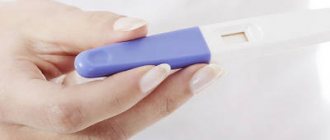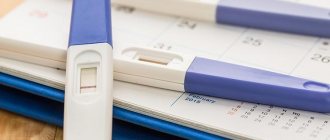At what period of delay does the test show pregnancy?
Whatever the reason for the lack of menstruation, you need to remain calm. First, find out the normal length of your cycle.
Adult women usually know this well, but young girls who have recently begun sexual activity are very worried. If you miss your period for only one to three days, you can just wait. During this period, it may turn out that there is no conception, but it is impossible to know about this. Even an ultrasound at this time will be uninformative.
It is impossible to answer the question at what period of delay the test shows pregnancy. Manufacturers usually indicate when after ovulation this test can be used.
The secretion of hCG (hormones indicating conception) becomes sufficient on the third to seventh day after fertilization. Only then do the tests show a positive result.
Delayed menstruation: pathology and norm
The menstrual cycle in women is a clear and well-functioning mechanism, but it can also fail. Only in some cases is a delay in menstruation considered normal, and in others a pathology.
And in general, is there a norm for delaying menstruation and how many days is it?
Dear women! You are all so different: young and “mature”, thin and plump, vulnerable and imperturbable. Therefore, the delay rate for each will also be different. For some of you, the absence of menstruation for two months will not be a pathology, but for some, a two-day delay will be a disaster.
So, let's figure out what situation should alert you and how many days of delay is considered normal.
Probable gestational age if delayed
It must be borne in mind that sometimes even after 14-20 days of delay, the test demonstrates that the woman is not pregnant. History knows of cases when a woman already has a large belly, but the test turned out to be negative.
Therefore, the situation with tests is ambiguous; you need to focus on the instructions. Let's look at a possible pregnancy day by day and the symptoms when menstruation is delayed for several days.
Delay 2 days
Pregnancy is considered from the last day of the first menstruation. To find out how long your pregnancy is, you need to add the number of days of delay to the usual cycle length.
If a girl usually has a cycle of 28 days, then obstetric pregnancy is calculated using the formula 28+2=30. That is, if there is a delay of 2 days, the period is 30 days (more than 4 weeks). Many tests on this day turn out to be negative because the concentration of hCG is insufficient.
Additional reasons for a two-day delay in menstruation.
Delay 3 days
The period according to obstetric standards is 28 + 3 = 31 days (more than 4 weeks). You need to understand that such a small delay may indicate a hormonal imbalance, and not conception.
Usually the woman does not experience any symptoms. The gynecologist will not yet be able to see any changes during a gynecological examination if there is a delay of 3 days. Some tests can show if you are pregnant.
Delay 4 days
At this period of 28+4=32 days, the amount of hCG hormone is 400-3500 mU/ml. 32 days of pregnancy is 4 and a half weeks. If you are 4 days late, you can use some tests to determine conception. At this time, the placenta and amniotic fluid continue to form.
The fetus already has a tiny head and develops three layers of cells that later form organs. Paternal genes are responsible for these processes. This cannot yet be seen with the naked eye or with ultrasound.
The mother may become irritable to tastes and smells, and nipple sensitivity may increase. Other expectant mothers are completely asymptomatic and feel as normal.
Delay 5 days
HCG at this time is 450-4000 mU/ml. The period is calculated as 28+5=33 days. This is 4 weeks and 5 days. Ultrasound examination using high-quality equipment shows characteristic changes. If there is a delay of 5 days, you can make an appointment with a gynecologist.
Why can there be a 5 day delay in menstruation?
Delay 6 days
The period is 28+6=34 days. This is 4 weeks and 6 days. HCG rises to 5000-7000 mU/ml. Associated symptoms such as nausea may appear.
In many women, with a delay of 6 days, the condition is similar to an acute respiratory infection due to a drop in immunity, which is necessary so that the immune forces do not reject the fetus, which is 50% foreign to the female body.
Delay 7 days
HCG is 5500-8000 mU/ml. Term 28+7=35 days. This is the last day that gynecologists consider not causing concern. Some women have regular cycle disruptions, this is explained by heredity.
If a girl constantly exhibits such signs, you need to ask older relatives. If your mother or grandmother's cycle lasted 35 days when she was young, the woman should not worry either. If there is a delay of 7 days (this is 5 weeks of pregnancy), you can register with an obstetrician-gynecologist.
Delay 8 days
Each woman's cycle is individual, but a delay of 8 days in a non-pregnant woman is unlikely. The period is 28+8=36 days. This is 5 weeks and 1 day of pregnancy.
Such a delay is considered normal not only during pregnancy, but also in the period preceding menopause or during lactation.
Reasons for menstruation delay from 8 to 10 days.
Delay 9 days
If a woman is pregnant and has a delay of 9 days, then they talk about a period of 28 + 9 = 37 days. This is 5 weeks and 2 days pregnant.
If fertilization is absent, then such a delay may indicate problems with the ovaries, uterus, endocrine glands and nervous system.
Delay 10 days
HCG during this period reaches 20,000 mU/ml, the period is calculated as 28 + 10 = 38 days. This is 5 weeks and 3 days pregnant. With a delay of 10 days, the fetal sac is already clearly visible during ultrasound examination.
It is clearly visible on an ultrasound if the pregnancy is intrauterine. In this case, an abortion is mandatory in order to save the life of the pregnant woman herself.
Delay 14 days or more
When a healthy woman with a normal monthly cycle experiences a delay of 14 days, this indicates both a pathology and a normal condition. The most common cause is pregnancy at 28+14=42 days. This corresponds to 6 weeks. In this case, you can focus on additional symptoms:
- nausea;
- breast growth;
- whitish vaginal discharge is evidence of the formation of a mucus plug, which is responsible for the safety of the fetus;
- increase in basal temperature;
- pain in the chest and lower abdomen;
- constant drowsiness;
- changes in taste preferences;
- mood variability.
Without gynecologists, it will not be possible to diagnose intrauterine pregnancy. For this reason, a woman definitely needs to see a gynecologist even after a week’s delay.
Sometimes a symptom of ill health is bloody smear from the vagina. In other cases, no signs are observed until the fallopian tube bursts and causes fatal bleeding.
Why are periods delayed by two weeks?
Additional reasons for a delay of 20 days or more.
What to do if the delay has reached two months and the test is negative.
General understanding of the menstrual cycle
The female cycle is divided into 3 phases:
- Menstruation. It lasts 3-5 days, during which the inner layer of the uterus is rejected and is accompanied by bleeding.
- Phase I, follicular. A 28-day cycle lasts 14 days. At this time, follicles - vesicles containing an egg - mature in the ovaries, and a new inner lining grows in the uterus. By the 14th day, the largest follicle bursts (ovulation process), the released egg penetrates the fallopian tube and meets the sperm. The edges of the burst bubble stick together, and a new formation is formed - the corpus luteum.
- Phase II (corpus luteum or luteal). It begins after ovulation, and also lasts an average of 14 days. Pregnancy begins in a woman’s body, the corpus luteum “blooms”, that is, it produces hormones that prepare the uterine cavity to receive a fertilized egg.
If pregnancy does not occur in the current cycle, the corpus luteum ceases its activity. The uterus rejects the inner lining as an unnecessary thing. And menstrual bleeding begins.
The ideal female cycle is 28 calendar days. But it’s rare that any woman can boast that their periods “run like clockwork.” For some, they arrive either earlier or later than the indicated value and range from 21 to 35 days.
The female body is individual. In order for a follicle with an egg to mature, it takes 10-12 days for one woman, and 15-16 for another. Hence the duration of the cycle is different: for some it is 21-24 days, and for others it is 30-35. Deviation from the indicator during a cycle, for example, 28 days plus/minus 7 days is also generally accepted as normal. The arrival of menstruation a week earlier or a week later in any cycle of at least 25 or 30 days is considered acceptable, i.e. within normal limits.
Before reading further, please take part in our little survey.
How to conduct the test correctly
The gestational age of a delay at home is determined by rapid tests that react to the presence of hCG in the urine. In the early stages, the content of the hCG hormone doubles every two days. The production of hCG begins from the moment the unborn baby is implanted into the uterine cavity. Tests are labeled 10, 20, or 25 mIU/mL.
The most accurate test is labeled 10 mIU/ml, theoretically it is used from the first day of menstruation. The most impatient women can start using such tests three or four days before their period; there is a chance that they will show two stripes.
Express tests are purchased at a pharmacy; you need to check the expiration date and the tightness of the packaging. The test is used once, you should urinate in a clean container. Morning urine is the most informative, especially at an early stage. If you need to carry out the test during the day, it is advisable to refrain from urinating for three to four hours. If a woman followed the rules, the probability of the result being correct reaches 95%.
Read more about when is the best time to take the test.
What is considered a delay?
If for some reason in phase I of the cycle there is no growth of a full-fledged follicle that could “release” a mature egg, then phase II will not begin. It’s all simple: if the follicle has not burst, then the corpus luteum will not form. And phase I can drag on for a very long time, until the inner layer of the uterus, greatly overgrown under the influence of hormones, begins to be rejected on its own. Therefore, the onset of menstruation is delayed from several days to several months.
The absence of monthly bleeding in a regular cycle for more than 7-10 days from the moment you expect it should be regarded as a delay in menstruation.
For a normal menstrual cycle, it is not so much the number of days between bleeding that is important, but the regularity of their recurrence. For example, if your menstrual cycle always occurs after 25-28-30 days, but this month menstruation did not occur on time, then this should be considered a delay. Especially if more than 7-10 days have passed since the expected day.
False results
In some cases, you can get two lines on the test without being pregnant. Even more often, a woman is pregnant, but only one line is visible on the test. In what situations can you get a negative result?
- Testing rules violated.
- The test was expired.
- The seal of the packaging is broken.
- A dirty urine container has been used.
- Testing was carried out with violations.
- Test taken too early.
- A woman has endocrine disruptions in her body.
- There is little hCG in the body, which threatens an early miscarriage.
If the test shows one line and there is no menstruation, you need to retest. If it turns out to be negative, be sure to make an appointment with a doctor. The gynecologist will prescribe a series of tests and find out for sure whether there is a pregnancy. The doctor will determine the approximate length of pregnancy if there is a delay or look for other reasons for missing menstruation.
Possible other reasons
A missed period does not always indicate pregnancy. Sometimes menstruation occurs later due to other reasons. These include.
- Consequences of abortion.
- Taking hormones.
- Stress.
- Diet.
- Diseases of the genital organs.
- Sport.
After termination of pregnancy, the general hormonal balance is disrupted. Menstruation after an abortion usually begins 40 days later. You need to understand that this should not be the case, so if you encounter this problem, immediately contact your gynecologist. The doctor will do tests and prescribe hormonal treatment.
One of the reasons is stress.
Sometimes a girl worries, counts how many days the delay lasts, but the point is not in pregnancy, but in taking hormonal contraceptive pills. The purpose of contraceptives is to suppress ovulation, and this causes “ovarian hyperinhibition” syndrome. In order to confirm ovarian dysfunction, the doctor either completely abolishes oral contraceptives or prescribes others.
Long-term and short-term stress can provoke an ovulatory abnormality, resulting in a delay in menstruation even in the absence of pregnancy. Problems occur when:
- severe shock;
- emotional turmoil;
- severe physical and emotional fatigue.
Also, climate change can be a reason for delay.
Many girls strive to lose weight through diets. At the same time, fasting deprives the body of valuable substances and essential vitamins. The result is hormonal imbalance.
There is a special term “critical menstrual weight”. The first menstruation occurs only if the teenager has gained the required number of kilograms. If a mature woman begins to lose a lot of weight, her periods may simply stop.
Therefore, if you are on a strict diet and there is a delay, you should not count how many days it occurs during pregnancy. Start eating well.
Pathologies of the genital organs often cause disruptions in the menstrual cycle. The culprits are:
- polycystic ovary syndrome;
- inflammation of the appendages;
- uterine fibroids.
If these diseases are not treated, serious complications can arise, the worst of which is female infertility.
Failure of the menstrual cycle
A delay in menstruation in the absence of pregnancy for several days is sometimes caused by playing sports. But only if you lift weights or prefer strength training. In this case, your period comes later by a maximum of five days.
Body care and proper nutrition
As soon as it becomes clear how many days of delay you can determine the exact duration of pregnancy, and you realize that you are expecting a baby, you need to start carefully monitoring yourself. It is very important to eat right, take care of yourself and prepare for childbirth.
After a delay in menstruation and the onset of pregnancy, serious changes begin in the body, to which you will have to adapt.
- The heart works with increased load, lung volume increases.
- Due to changes in the digestive organs, the woman feels nausea and vomiting.
- The joints of the pelvis begin to transform, so some pregnant women may acquire a “duckling” gait.
- Transformations also occur at the psychological level. A woman’s mood is influenced by hormones and is constantly changing.
Don't neglect your body care. Of course, pregnant women should not visit a solarium, spend a lot of time on the beach and regularly exhaust themselves with complex fitness workouts, but special exercises will not hurt.
There are programs for pregnant women that prepare the body for childbirth:
- today you can sign up for special centers that offer classes in adapted water aerobics, gymnastics, and childbirth;
- You can practice dancing if it is taught by a qualified trainer.
Pay attention to massage. Naturally, it is not anti-cellulite, even if you notice orange peel on your thighs. There are special massage programs that differ from the classic one in that they exclude vigorous rubbing. Only relaxing, stroking techniques are used.
It is important to follow a proper diet. Choose only healthy products that are necessary for you and your baby.
Regardless of the stage of pregnancy, you need to adhere to certain nutritional principles. There are several of them.
- Avoid alcohol, fried and spicy foods.
- Reduce the amount of fat, salt and liquid you consume.
- Eat regularly.
- Prepare fresh food for every meal.
In the first half of the term, you need to eat 4-5 times a day in small portions at a certain time. Dinner should be three hours before bedtime, otherwise the gastrointestinal tract will have to cope with overload.
All foods that pregnant women need to eat are divided into six groups.
- Vegetables.
- Poultry, fish, meat, eggs.
- Fats.
- Pasta, bakery products, potatoes, sugar, cereals.
- Milk, cottage cheese, fermented milk products.
- Fruits, berries.
From the fourth month, the baby begins to develop intensively, so he needs to eat more proteins. Eat more sprouted grains, nuts, vegetables, herbs and fruits. It is imperative to exclude from the diet:
Should you panic if your period is already 10 days late and the test does not show conception?
If the delay is 10 days, the test shows a negative result, many girls begin to panic. They don't understand what's happening to them. Is this condition a sign of a serious illness?
Modern pregnancy tests are so sensitive that they can determine an interesting position from the first days of a missed period. If the test does not determine pregnancy, does it mean that the reason for the lack of menstruation is a violation of the body?
In fact, there can be many reasons for a missed period with a negative pregnancy test result. And not all of them indicate the development of the disease.
Can the test result be wrong?
The probability of diagnostic error using the test is quite high. A defective or expired product may not detect the pregnancy hormone (human chorionic gonadotropin, hCG) in the urine and show a negative result.
If several repeated tests do not reliably detect pregnancy, the test may be performed incorrectly. Before using the product, you must carefully read the instructions and strictly follow its instructions. For research, it is better to collect morning urine, which contains a higher level of the hCG hormone. More recent generations of tests are highly sensitive. Therefore, it is recommended to use them to determine an interesting position.
As pregnancy progresses, some women secrete little hCG hormone. In this case, in the first month after conception, its concentration in the urine is low.
Even highly sensitive modern tests of new generations cannot always detect small amounts of the hormone. But as pregnancy progresses, more and more hormone is released. Therefore, a repeat test done after 1-2 weeks will detect it with you
Source
How to become a happy mother
Causes of delayed menstruation in teenage girls
In the teenage body, physiological changes in hormonal levels are observed, so for this category of “women” a delay of 10 days in menstruation is not a global problem. It takes time for hormonal levels to establish, and by the age of 14–15, a teenage girl has a regular menstrual cycle. Further deviation indicates a problem, and it is important to visit a medical center.
One way or another, a delay in monthly menstruation requires high-quality diagnosis. The fact of pregnancy (during sexual activity) and diseases of the reproductive system should not be ruled out. A genetic predisposition is also relevant, when instability of the menstrual cycle is transmitted from mother to mature daughter. In any case, a visit to the doctor will not be in vain.
Return to list
Delay 10 days test negative forum
Statistics: the test is negative, but there is a pregnancy
The test did not show 10 days after the delay. Moreover, the blood test for hCG was negative. I don’t even know what kept me from getting drunk out of grief after this negative analysis.=. Probably intuition.
But simply for a number of reasons, for the first time in several years, the ovulation date has somehow shifted. We declassified our miracle day on the 11th delay only.
I had a very pale line after 10 days of delay. just like some kind of ghost, barely. but I constantly wanted to sleep, both night and day. I thought I was nervous. and then it turned out B..
I had the same thing. HCG was also negative and I calmly began to wait for M and the next cycle. I waited and waited for another 15 days. Also, apparently O was late, so the day before the pre-term M hCG and tests during the 10 days of delay showed nothing.
This is how it is for me now. in the same situation and also the beginning of the cycle. I can’t buy a test yet, there’s a one-day delay. I want to sleep badly and there are suspicions of ber.
Negative tests on days of delay can only occur if the cycle is not stable, i.e. Ovulation is late and there is actually no delay.
That’s how it is for me now: I’m already on the 6th day of delay if I take into account my recently stable 30-day cycle. It turned out to be late O. Already at 25 DC (5 days before the expected M). So my countdown of days of delay has shifted. But because BT remains high, I started testing. I've tested it 4 times already. Today I’m either imagining things or just my fantasies. What did I look at where the test strip was? Although I still use cheap tests (Eva test for 11 rubles). Yesterday I bought Evitest for 150 such a cassette with a pipette. I've never used these before. In fact, I’m only 11 DPO now. So IMHO it's too early to do tests.
Pregnant
Source
Signs and symptoms of pregnancy
If you are pregnant for the first time, then you may well not notice these first signs of pregnancy or confuse them with symptoms of your impending menstruation.
You shouldn’t spend long hours searching for answers on forums in worry; in any case, your research will not change what has already happened or has not happened, but it can seriously spoil your mood and sleep.
| Minor pain in the lower abdomen and spotting | 1-4 week |
| Lack of menstruation | 4 week |
| Fatigue | 4-5 week |
| Nausea | 4-6 week |
| Breast swelling | 4-6 week |
| Frequent urination | 4-6 week |
| Constipation | 4-6 week |
| Dizziness when moving | 5-6 week |
| Mood swings | week 6 |
| Temperature changes | week 6 |
| High blood pressure | 8 week |
Pain and slight bleeding
From 1 to 4 weeks, changes in a woman’s body occur at the cellular level. The fertilized egg creates a group of cells filled with fluid called a blastocyst, which will later develop into organs and body parts of the fetus.
Approximately 10-14 days after conception (week 4), the blastocyst attaches to the endometrium lining the uterine wall. This process may cause slight bleeding, which can be confused with a light period.











